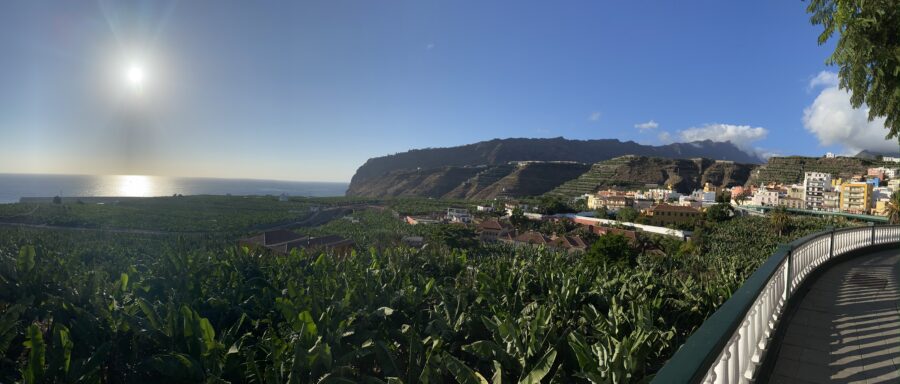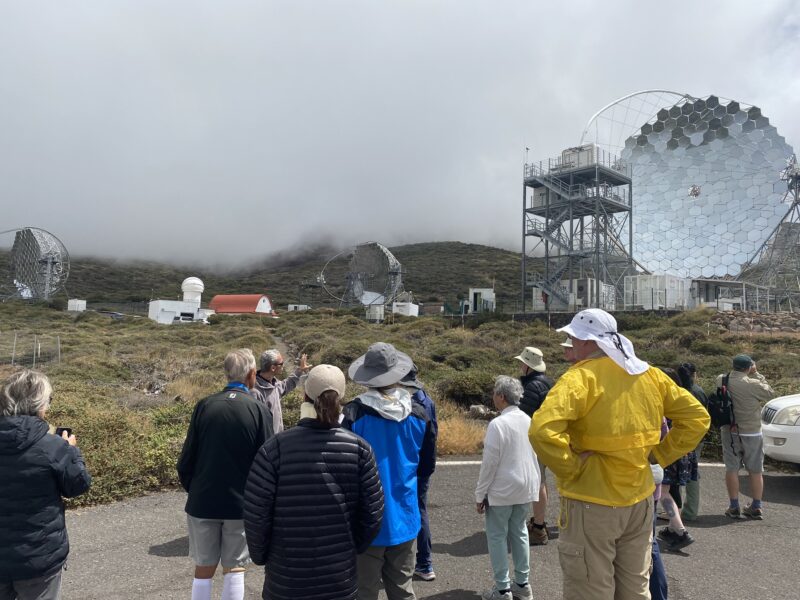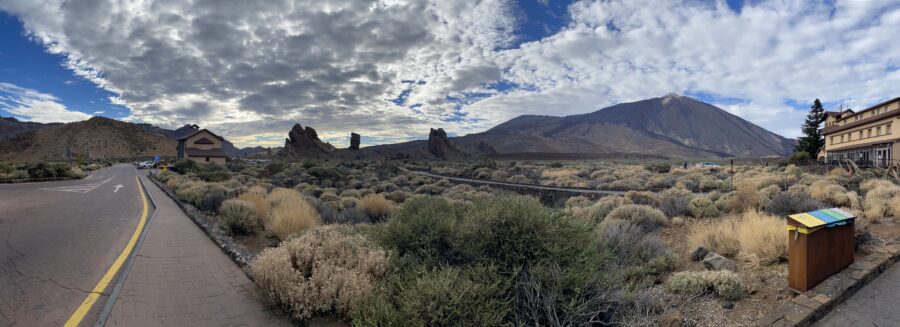The week of September’s new Moon, a passel of astro-enthused passengers explored one of the world’s premier observing locations.
Splattered in a crooked string off the coast of Morocco lie the Canary Islands, a volcanic archipelago claimed by Spain since the 1400s. They’re geologically young, formed over the last few tens of millions of years above mantle hotspots that push on the overlying crust — a process that continues today as new islands slowly grow beneath the waves.
Favored by trade winds and a surprising diversity of climates, the islands have a rich history. They were the abode of the now-gone Guanche people, a pit stop for Spanish ships crossing the Atlantic, and a haven for winemaking when pestilence demolished vineyards across Europe in the 19th century.
They’re also home to some of the world’s best skies.

Camille Carlisle / S&T
Sky & Telescope’s tour group began its adventures among the banana plantations of Tazacorte, a small town on the west coast of the island of La Palma. Los palmeros value their night skies, and shielded, amber-hued streetlights illuminate the cobblestoned roads. A 3-second exposure with my less-than-sparkling-new smartphone picked up hints of the dust lanes in the Milky Way just outside our historic hotel, and the Sagittarius Teapot and Scorpius were in plain view. Travelers with snazzier cameras did much better than I.
Two years ago, this part of the island was besieged by a volcanic eruption. Over three months, the eruption buried homes and businesses beneath lava and ash. The peak formed by the activity still steams today, its slopes covered by yellow sulfur much like that you’ll see in images of Jupiter’s volcanic moon, Io. A 5.2-km trek took us trudging through the black grit for a panoramic view.

Camille Carlisle / S&T
En route to lunch after our hike, we encountered our own calamity: An oncoming driver crossed into our lane and crashed headlong into our bus. The impact sent us careening into the guardrail and blocked the small, two-lane road with debris.
Miraculously, our driver, passengers, tour guides, and I suffered only minor injuries. Our bus wasn’t so lucky.
The problem of finding new transportation aside, the crash left us with a hard decision. Should we go on? We were shaken and bruised; some had stitches and wore braces. But ultimately, every passenger chose to board the new bus the next day and continue with the tour.
La Palma
And what a tour it was! The next day we climbed some 2,400 meters (7,900 feet) to the Roque de los Muchachos Observatory on the rim of Caldera de Taburiente National Park. There we enjoyed private tours of several facilities, including the Gran Telescopio Canarias. With a 10.4-meter primary mirror made of 36 hexagonal segments, GTC is the largest optical telescope in the world. As it points to different parts of the sky, it actively adjusts its mirrors to counteract deformations created by its 400-ton weight.

Camille Carlisle / S&T
After lunch on site, we continued with tours of the MAGIC (Major Atmospheric Gamma Imaging Cherenkov) and William Herschel telescopes. MAGIC’s two telescopes take a unique approach to studying the high-energy universe. A single gamma ray from a distant cosmic explosion can have the energy of a bullet, and when that gamma ray smashes into Earth’s atmosphere, it creates a shower of particles that emit lower-energy, optical-wavelength photons. It’s these photons that MAGIC — and its in-the-works partner, the Cherenkov Telescope Array Observatory — look for.

Camille Carlisle
After an exquisite dinner at Rincón de Moraga in Los Llanos de Aridane, we joined members of the local amateur astronomy association at the Llano Del Jable Astronomical Viewpoint for some stargazing. Unfortunately, shortly after our arrival we were skunked — a freezing wind and clouds enveloped what is normally a fabulous observing site at 1,300 meters, and we were forced to flee back down to sea level.
But it was the last time our observing plans were scuttled. The next day we drove to the island’s east coast for a tour of La Palma’s capital and a wine tasting on the deck of a replica of Columbus’s Santa María. Then it was back to Tazacorte’s port to meet our sky guide, Ana García Suárez (Astro La Palma). On our evening cruise she regaled us with stories of the stars as she and her green laser pointer helped us navigate the constellations and the satellites whizzing among them.

Camille Carlisle / S&T
Tenerife
On day five, we said ciao to La Palma and hopped a short flight eastward to the island of Tenerife. After a delightful seaside lunch, we climbed skyward to our hotel in Teide National Park. Perched at some 2,150 meters, the hotel lies surrounded by a breathtaking volcanic landscape. Here, we ran into members of the British Astronomical Association on their regular astrophotography pilgrimage to the Canaries — what good luck!

Eric Reed
After toasting the sunset with cava (because heaven help you if you call Spanish sparkling wine champagne), we joined Raquel and Carmelo of AsterArk on the hotel’s back patio area — complete with piers ready for astronomers’ use — and enjoyed the sky through the 9.25-inch and 10-inch Schmidt-Cassegrains the duo had brought. Raquel left at least one traveler giddy when she attached a diffraction grating to reveal the spectral differences of Albireo’s two stars.

On our last full day, we trekked up to Teide Observatory. Tenerife’s recent fires had threatened the observatory, but the telescopes had survived unscathed. Thanks to the hard work of our local tour manager, we had a permit that enabled us to pass the barricade blocking the access road and wind our way up the mountain. There, we received a marvelous tour of the facilities, including the QUIJOTE experiment, which searches the cosmic microwave background for fingerprints of the stupendous growth spurt hypothesized to have occurred some 10 nano-nano-nano-nanoseconds after the Big Bang.
By now we were so well victualed that it was hard to eat any more, but eat we did . . . and then took a cable-car ride up to the summit of Mount Teide, one of the highest points in Spain. And after a final dinner and the pain of parting ways, we bid farewell — until the next S&T tour.
 1
1









Comments
Michal
September 28, 2023 at 1:22 pm
After reading of the scary head-on incident with the bus on La Palma, I was a bit rattled to later read that "we ran into members of the British Astronomical Association". Hopefully no injuries there, either! Glad to hear all were well and had an enjoyable adventure.
You must be logged in to post a comment.
You must be logged in to post a comment.